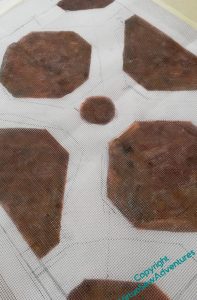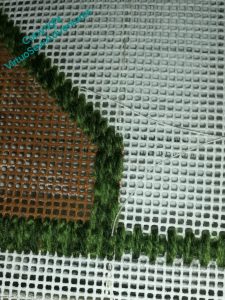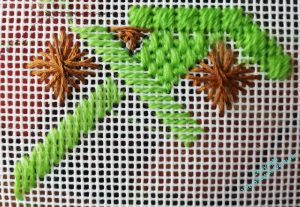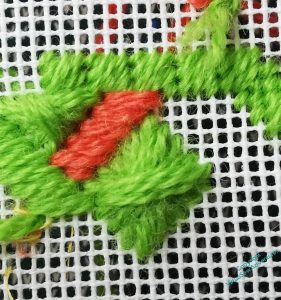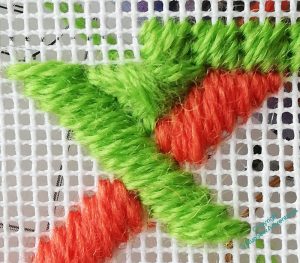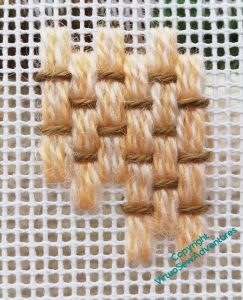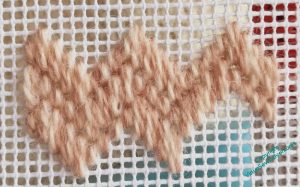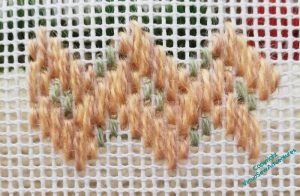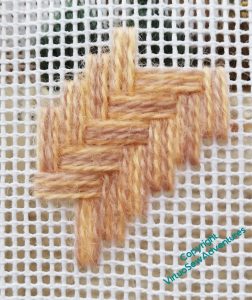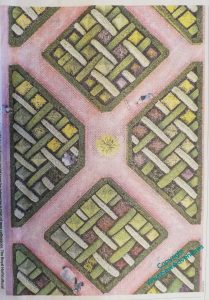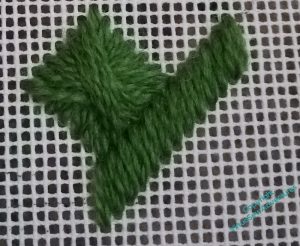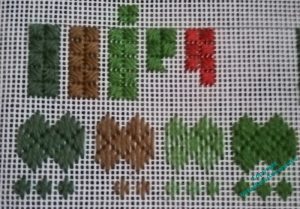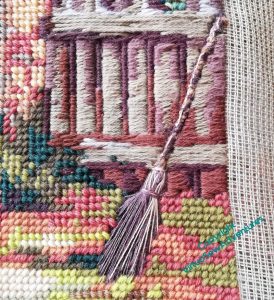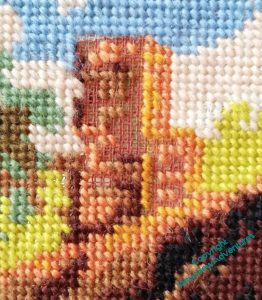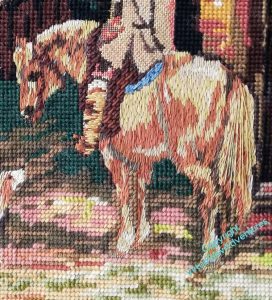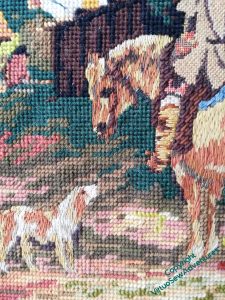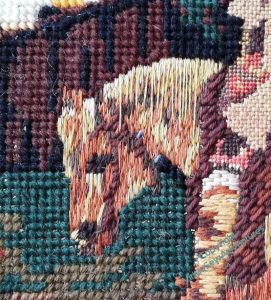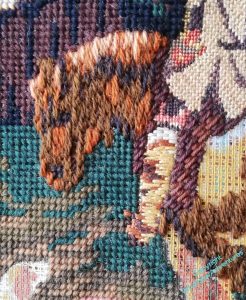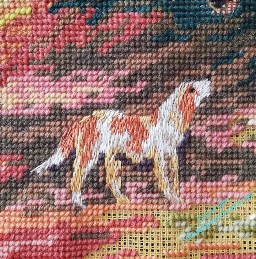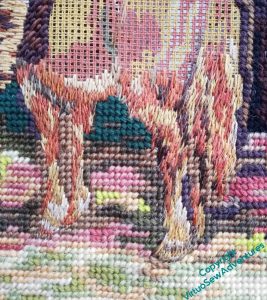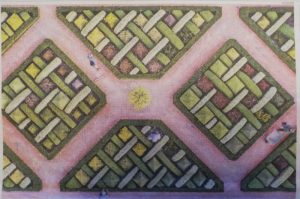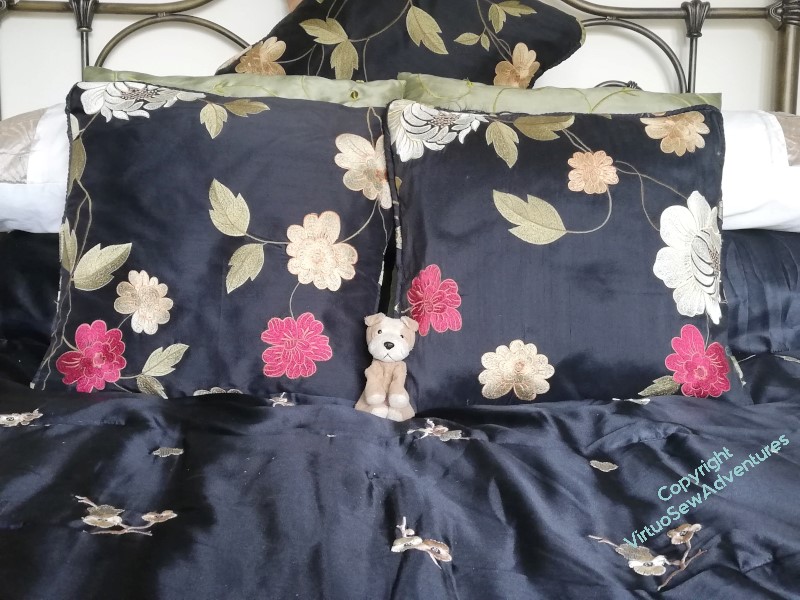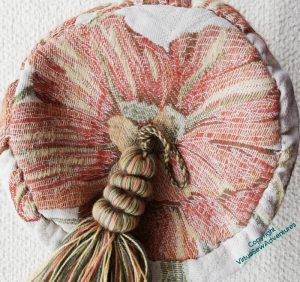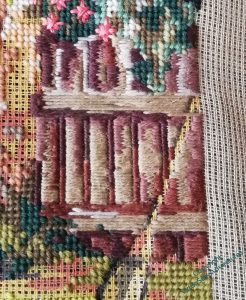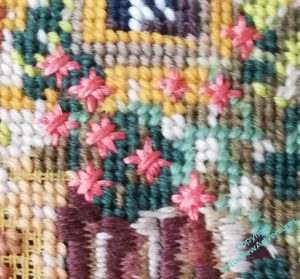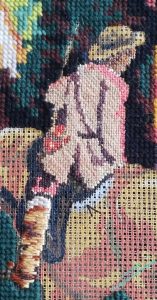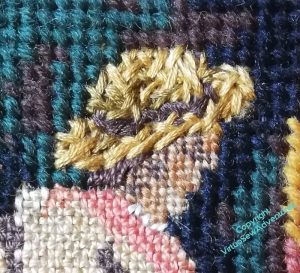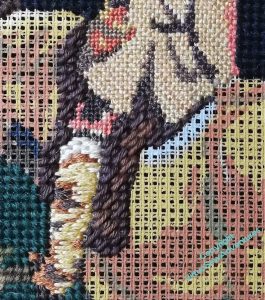Tag: canvaswork
Beginning The Knot Garden
A “Site Visit” recently gave me the chance to look at my wools in the room for which the cushion is destined, and to talk to my cousin about the whole thing. It also provided a reminder of the truism that, no matter how extensive the stash, for any particular project, the stash will prove inadequate!
I had my experimental panel with me, and one of the things my cousin said was that she was not particularly taken with the effect of the tent stitches or straight stitches infilling between the pattern stitches. I agreed that it looked a bit clunky and congested, so when I got home again, I got out my acrylic paints and painted the canvas, just the area of the borders.
What I have done is to use three different shades of brown, solo and in mixtures. And I’ve painted both sides of the canvas, to make the coverage a bit more thorough. This way, I’m not trying to produce an absolutely flat colour, as though the canvas were dyed or coloured from the start.
You can also see in this picture that the “pathways” spill out into the surrounding canvas. I was intending the stitching to do so as well, but there’s an old saying in military circles, that “No plan survives contact with the enemy”. I would adapt that for stitchers – I don’t regard the canvas as my enemy, but no plan survives the first stitching session unchanged!
I started to work the Parisian Stitch border around the beds, using two different colours of crewel wool in the needle, and soon decided that although I want to have a couple of rows of tent stitch around the outside, to help with adding the back to the cushion, I also want the pattern area properly delimited. So the line between the beds will be filled with a line of Parisian stitch as well.
Testing, Testing (phase 3)
There is still much to play with, with regards to the the stitching for the Knot Garden Parterre.
At this point, I’m trying to balance accurate impressions – and therefore useful testing – with not tearing my thread to pieces or wasting any of it. At present I am still thinking of doing this out of stash, if possible, which is why I’m using an impossibly bright shade of green here – I’m unlikely to want it in the real thing!
Now, you see here that the short Parisian Stitch enticed me into a broader strap than I was intending, and it has unbalanced the Mosaic Stitch of the border, which in turn became Scotch Stitch as it turned into the diagonal, and lost the pattern it had.
Here, by contrast, I have demonstrated one of the other hazards of canvaswork, especially for my astigmatic eyes – I’ve suddenly managed to turn a Diagonal Rhodes Stitch into a slightly oblong and twisted diagonal Rhodes stitch. I didn’t see it happening, so I am going to have to guard against it with some care.
I think I need to make my stitches and straps bigger, too: the shape drawn on the canvas is the size of one of the ones on the finished piece, and I started the outer border on the centreline, and turned onto the diagonal at the appropriate point. The first horizontal row of diamonds should have two in it. Two properly square diamonds, that is!
And here you see the challenge I need to address: the diagonal Rhodes Stitches start with a horizontal or vertical stitch, so what I need in the angle between the straps is a gap (as you see top and bottom of this intersection) and not a thread (as you see left and right)
At this point I’ve been stitching and unstitching so often that I have lost count of myself, and keep on losing track of the stitch lengths I intend, so there will be a pause to regroup!
Testing, Testing (phase 2)
I’ve been playing around with possible stitches for the pathway in the Knot Garden. In the source picture, it looks to be made of bricks laid in a pattern, rather like a parquet floor.
I don’t feel I’m obliged to replicate that pattern, but this one on the left is altogether too square, and won’t help the sense of movement I’m going to need to counterbalance the borders, which I rather expect to be rather static, given all the Diagonal Rhodes Stitch that’s going to be happening.
The one on the right is the same Medieval Mosaic Stitch from Jo Ippolito Christensen that I used, voided, in the sunglasses case, but this time worked exactly as diagrammed. I like it, and it’s easy enough to work, but I don’t think it does the job I will be asking it to. I’m sure I will work it for real one day, but not for this project!
When I replaced the stitches that were voided in the sunglasses case with stitches in a different colour and thread, to point up the woven pattern, I got something a lot more hopeful…
I like this one a lot. Although I must admit it does rather recall the diaperwork you sometimes see on Tudor buildings, so maybe not very floor-like!
And then I found another, one that actually looks a lot like herringbone brickwork without any adaptation.
I like this one a lot, too.
I will have to see which of these presents itself most strongly when I’ve got more of the ideas crystallised.
Testing, Testing… (phase one)
Remember this, the Knot Garden parterre?
It’s going to require a little more precision and therefore a little more planning than I usually indulge in. So there’s also going to be a bit more experimentation than usual. I might not go to the length of actually charting the finished piece, but I’m certainly intending to have a very clear idea of what is going where, and what thread or threads I’m going to use.
I’ve been intrigued to note that, from pulling out a huge variety of threads to use, an assortment of fibres and an assortment of colours, I’m beginning to restrict my ideas to a much smaller palette of threads and stitches.
As I looked at the picture more closely, it became clear that the squares within the beds were topiary pyramids. Maybe some are suffering from box blight, hence the colour variations, but this gave me a good place to start experimenting. I’ve gone to the trouble of framing up a piece of the canvas I’m going to use, so as to experiment properly, and my first observation is that I am going to need to be on top form when I work this, because it’s dreadfully easy to go adrift!
However, I think it’s fair to say that Diagonal Rhodes Stitch makes a fine pyramid in topiary! The straight stitches are in the same colour, which they won’t be, but I think the stitch length, compared with the Rhodes Stitch, looks about right for the width of the little hedges that create the strapwork effect.
I’ve also been testing out other threads and stitches – tapestry wool, soft embroidery cotton, stranded cotton. I want to have varying textures and patterns within the strapwork, creating a nice harmonious whole – but a stitched harmonious whole. I could easily chart – or even freehand – a tent stitch reproduction of the picture, but it wouldn’t have the personality needed for the place it’s going to live. Textured stitches will help to create that personality.
Last details..
The birch besom leaning up against the fence rather caught my attention, because we had one when I was a little girl, and I’ve not seen another for years. Like all these low-tech looking things, it takes more to make one than you’d think, but they are good at what they’re good at.
They’re harder to make in stitches than you’d think, as well. I’ve used some fine unmercerised cotton, and some of that accursed stranded linen that DMC used to produce. Honestly, I’m all in favour of experimentation, but what one earth were they thinking? It’s ridiculously fragile, even on a fabric with huge holes, it’s uneven without being pretty, and it doesn’t even produce texture. But it was the colours I needed, and I didn’t want any shine…
At this point, I frolicked gently – it’s finished! – and took it off the frame.
Only to discover that, in fact, it wasn’t finished!
One colour of the chimney and a bit of one of the clouds remained unstitched. This wouldn’t have happened if I’d been working on it from the start, but as it was passed on by someone else, and I think, looking at the stitching, that at least two someones before me were involved, I’m not surprised to find bits missing. Fortunately, they weren’t hard to fix!
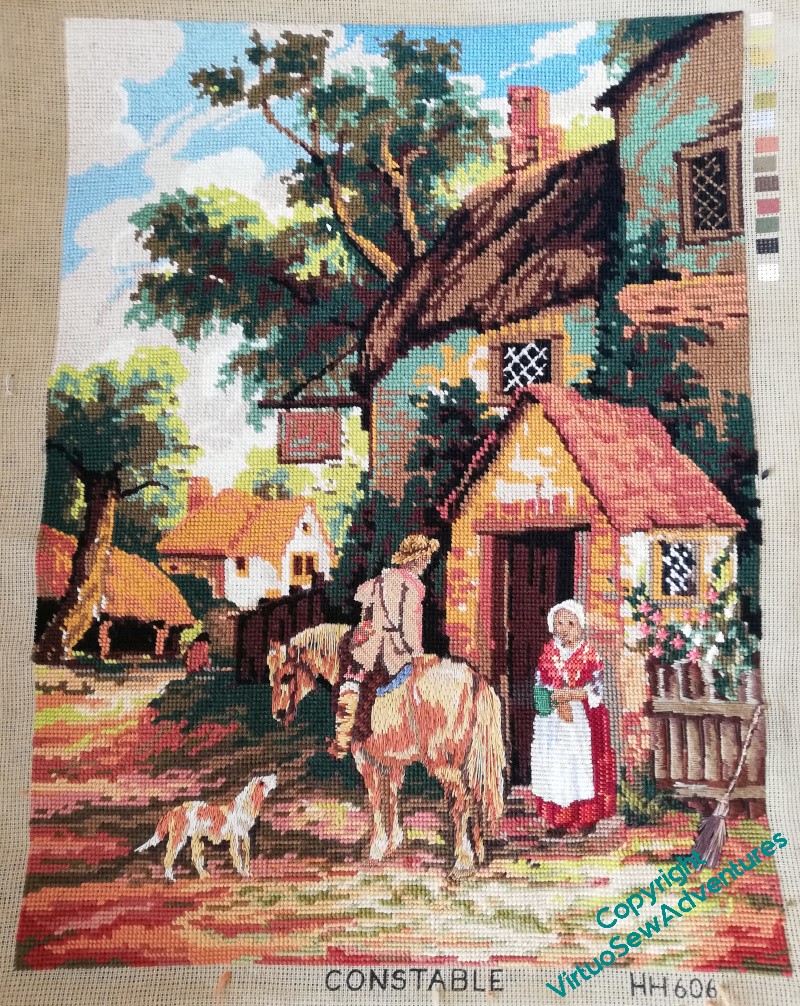
And now it really is finished! It’s turned out much better than it might have done, and it wants blocking and mounting in some way, but I think our local charity shop stands a chance of selling it once that’s done..
Update: my cousin is looking to furnish her office and has asked for it in return for a donation to my pet charity!
Dobbin
Dobbin covers quite a bit of the canvas!
Once I’d done all the masses of what for want of a better term I am going to call long and short stitch, using blends of stranded cotton, I sat back and looked.
I’ve added some long stitches to the tail, using two differently coloured strands of stranded cotton twisted together. I’m not sure whether to add more of this, or even whether to leave it in, but I wanted to help emphasize the length of the tail, and this is one way to do it.
The conversation is very clear to see now, I think. The colours are similar, but not the same, the technique is the same, and there is a real sense that Dobbin and the dog (Polly the pointer?) are having a proper catch-up.
I wonder what they are talking about?
Actually, once I looked at the conversation as it stands, I thought there was a little still missing…
That’s better.
It’s nothing like the thickness the mane would truly have, but I think it gives just the right recollection of the shaggy long hair of Dobbin’s mane, and the blue cotton on the harness and the back of the saddle suggest sunlight on the leather.
He’s turned out much better than I feared!
A second conversation
You may recall that I started on the horse in the canvaswork, and then suffered from Doubts. I thought it looked an unholy mess, and diverted my thoughts to the fence by the cottage. Which turned out very pleasingly, which is always a relief.
Then my cousin made a passing comment that helped me unstick the problem – she said that there are two conversations going on in the picture, one between the man and the woman, the other between the dog and the horse. That being the case, it seemed to me that I should maybe use the same technique for the dog and the horse, even the same sort of thread, so as to highlight the conversation.
I wanted to create the impression of fur, but nothing too shaggy, so while I wrestled with unpicking the horse, I started on the dog. Stranded cotton, separated and recombined using several close colours (I have a lot of stranded cotton, so this is all still stash), and then worked upward from the feet and the end of the tail in something a bit like long and short stitch.
I think this has worked well. We have friends whose dog is a similar shape and colouring to this one, and it was fun to sit and stitch with her in mind.
Of course, an entire horse (I’m calling him “Dobbin”, of course!) is going to take some time to do, since I need to work upwards. But at least I’ve made a good start here, smaller stitches around the hoof, longer stitches, with still longer ones planned, for the tail.
He’s a rough-coated working country horse, not a sleek and shining racehorse, so if the colours are clouded a bit, and the darks and lights not as distinct as they might be, that’s all to the good.
I’ve continued to work on the tent stitch, too, every which way, as it is in the sections already worked when I got the canvas, so the whole thing is getting closer to being finished..
A Site Visit
The next canvaswork project, commissioned by my cousin, has had a slight change of direction. It is still based upon this drone shot, but it is to be full coverage rather than voided stitches, and it’s going to sit on her bed, worked in colours from the curtains, to pull those colours onto the bed.
So when I went to visit a few weeks ago, I did a site visit – as shown here, including the Hound of the Doleful Countenance, for scale. We’ve decide that the final cushion is to be a rather Biblical cubit in length (that is, forearm from elbow to fingertips), which will go from the middle of one black cushion to the middle of the other, and at least a handspan high.
I’ve also brought home the cover for the doorstop, in the fabric I need to reflect in my thread choices – which means, not only did I not have such a weight to bring home, but my cousin also still has her doorstop!
My next job is to draft out the pattern to transfer to the canvas. Once upon a time, I had canvaswork design software, and I might have tried to chart a design first, but it didn’t include some of the stitches I might want to use, and with so many of the more unusual threads in my view, I will be doing a lot of experimenting along the way!
The fence by the cottage
I intended to work the horse using Paterna, in something a little like long and short stitch, but having done his head, I looked at it and decided it needed a little more thought. It looks like some sort of unholy hybrid of horse and highland cow, and I wasn’t at all sure that it would look better when I’d done all of it. So I decided to divert my attention elsewhere and think about it for a little longer.
The most obvious element to tackle next was the fence, which is so far the only piece to be done in horizontal stitches. I’ve used soft cotton, which has nearly enough body to stand up to the tapestry wool, and slightly more sheen, which also helps. You’ve probably noticed that I haven’t extended my diversion to the broom, which looks a lot more like the birch besom my grandmama used to use in the garden. That’s likely to be last of all, as I want to raise it over the rest of the stitching.
Since I was working at this size of the canvas I was reminded that I’d been leaving gaps for some of the flowers. Diagonal Double Cross Stitch makes for some huge flowers, which might very nearly be the size of dinner plates if scaled up and aren’t at all cottagey – more Professor Branestawmy, in fact! – but they do stand out nicely against all the tent stitch, and they’ve enough personality to live with the fence, too..
The Rider
When I first started looking at this canvas, I was reminded of the episode of “A Stitch in Time” in which Ninya Mikhaila did a reconstruction of the garment in a portrait of a hedgecutter on a country estate. The garment in question was made of leather or buckskin and very plainly at least 50 years behind the fashion at the point at which it appeared in the photo. So it had been made for the Squire, and then gradually been passed from hand to hand, appearing to be almost indestructible, if not as good looking as before. So my first thought was to use soft cotton. However, I don’t have much soft cotton in my stash, and it turned out too heavy for the canvas anyway, so I used pearl cottons and Caron Collection “Watercolours” thread, one strand of the three. Linen stitch is what basketweave tent stitch looks like on the back, and although it can be a bit tricky to do, and it’s more time-consuming than basketweave tent, it’s worth the effort!
As with the lady at the cottage door, I blended several different shades of stranded cotton to create the approximate shades for the face, and used petit point to bring in a little more detail.
The hat was a bit more of a challenge, but in the end I decided it was a woven straw hat rather than a felt one, and created a criss-crossing effect, with something like herringbone stitch, but worked in a rather freestyle fashion.
The pouch hanging at his waist is stranded cotton, tiny cross stitches using the single crossing points of the canvas, and I decided to make his breeches in Kelim stitch, hoping it would make a sort of corduroy effect.
Not really, as it turns out, but it was worth a try!
The saddle is soft cotton, and I’ve used condensed mosaic stitch. I want the level of shine to contrast with the horse, which is probably going to be in Paterna.

